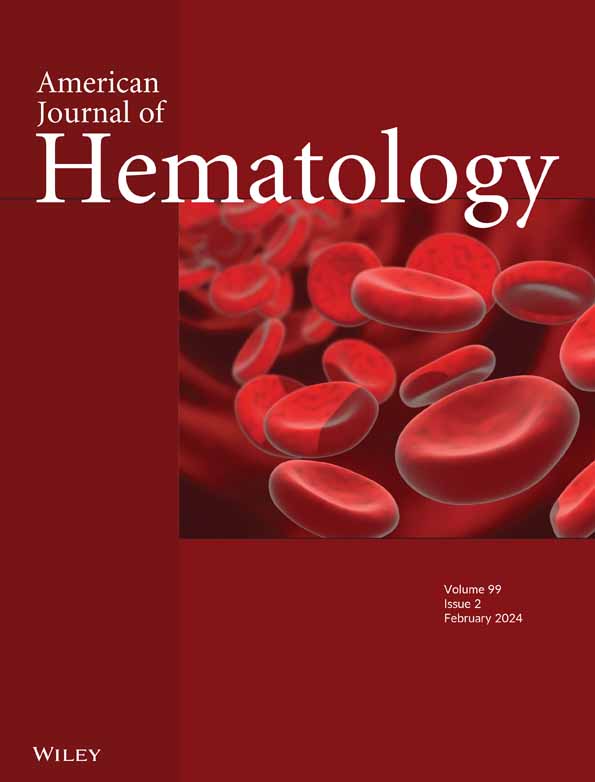Recursive Partitioning to Differentiate Acquired From Inherited Bone Marrow Failure Syndromes.
IF 9.9
1区 医学
Q1 HEMATOLOGY
引用次数: 0
Abstract
Distinguishing inherited bone marrow failure (IBMF) from acquired aplastic anemia (aAA) at diagnosis is a major clinical challenge and is essential for appropriate treatment and patients' counseling. Genetic testing to exclude IBMF is frequently subject to delays of several months and may not be available in all centers and could not be applied to all patients in a large number of countries. Our study aimed to develop a practical scoring system to identify patients who are unlikely to have IBMF. Patients in the training set (N = 150) were classified as having either aAA or IBMF based on genetic results and/or response to immunosuppressive therapy. We retrospectively recorded 33 clinical and laboratory characteristics at the time of diagnosis. The diagnostic algorithm was then constructed using recursive partitioning. This unbiased model handles missing values using conditional inference procedures. Model sensitivity addresses the ability to correctly predict aAA. Three of the variables of interest were selected by the model in the final algorithm: morphological abnormalities, PNH clone (≥ 0.1% on granulocytes), and acute onset of BMF (cytopenia < 1 year). In the training set, the algorithm achieved a sensitivity of 96.2% (IC95%: 91.4%-98.8%) and a specificity of 88.2% (IC95%: 63.6-98.5) in differentiating aAA from IBMF. We then applied this algorithm to a validation set of 465 patients (aAA n = 368 (79.1%); IBMF n = 97 (20.9%)) and obtained similar sensitivity of 95.7% (IC95: 93-97.5) and specificity of 91.8% (IC95%: 84.4-96.4) with a positive predictive value of 97.8% (IC95%: 95.7-99). This efficient and practical scoring system might help physicians to identify patients who do not need genetic screening, allowing prompt start of treatment. Positive predictive value may be improved in specific populations by adding telomere length, AFP and HbF values.递归划分以区分获得性和遗传性骨髓衰竭综合征。
在诊断时区分遗传性骨髓衰竭(IBMF)和获得性再生障碍性贫血(aAA)是一项重大的临床挑战,对于适当的治疗和患者咨询至关重要。排除IBMF的基因检测往往要延迟几个月,可能无法在所有中心提供,也无法在许多国家适用于所有患者。我们的研究旨在开发一种实用的评分系统,以识别不太可能患有IBMF的患者。训练集中的患者(N = 150)根据遗传结果和/或对免疫抑制治疗的反应被分类为aAA或IBMF。我们在诊断时回顾性记录了33个临床和实验室特征。然后利用递归划分构造诊断算法。这个无偏模型使用条件推理过程处理缺失值。模型敏感性解决了正确预测aAA的能力。模型在最终算法中选择了三个感兴趣的变量:形态学异常、PNH克隆(粒细胞≥0.1%)和急性BMF发病(细胞减少症< 1年)。在训练集中,该算法鉴别aAA与IBMF的敏感性为96.2% (IC95%: 91.4% ~ 98.8%),特异性为88.2% (IC95%: 63.6 ~ 98.5)。然后,我们将该算法应用于465例患者的验证集(aAA n = 368 (79.1%);IBMF n = 97(20.9%)),敏感性为95.7% (IC95: 93-97.5),特异性为91.8% (IC95%: 84.4-96.4),阳性预测值为97.8% (IC95%: 95.7-99)。这种高效实用的评分系统可以帮助医生识别不需要基因筛查的患者,从而及时开始治疗。在特定人群中,增加端粒长度、AFP和HbF值可提高阳性预测值。
本文章由计算机程序翻译,如有差异,请以英文原文为准。
求助全文
约1分钟内获得全文
求助全文
来源期刊
CiteScore
15.70
自引率
3.90%
发文量
363
审稿时长
3-6 weeks
期刊介绍:
The American Journal of Hematology offers extensive coverage of experimental and clinical aspects of blood diseases in humans and animal models. The journal publishes original contributions in both non-malignant and malignant hematological diseases, encompassing clinical and basic studies in areas such as hemostasis, thrombosis, immunology, blood banking, and stem cell biology. Clinical translational reports highlighting innovative therapeutic approaches for the diagnosis and treatment of hematological diseases are actively encouraged.The American Journal of Hematology features regular original laboratory and clinical research articles, brief research reports, critical reviews, images in hematology, as well as letters and correspondence.

 求助内容:
求助内容: 应助结果提醒方式:
应助结果提醒方式:


